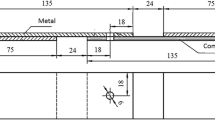This paper presents the results of the research into the influence of heat treatment, with application of differential parameters and gas atmosphere, on the friction coefficient during the tightening of a bolted joint. The study consisted of several stages – it included metallographic examinations, hardness evaluation and joint tightening tests. This paper presents the research process, the obtained results and the analysis of the impact of thermochemical treatment on functional parameters, such as friction coefficient and torque, during the tightening of a bolted joint.















Similar content being viewed by others
References
J. H. Bickford, Handbook of Bolts and Bolted Joints, CRC Press (1998).
M. V. Bobylev, “Quenching of rolled shapes of low-carbon steel from the intercritical range: an effective method for manufacturing high-strength fasteners,” Metal Sci. Heat Treat., 44, No. 1, 63 (2002).
L. G. Satanovskii, “Heat treatment of fasteners in production lines (from foreign technology),” Metal Sci. Heat Treat., 21, No. 5, 346–349 (1979).
S. I. Ivanov, N. G. Trofimov, É. I. Freidin, et al., “Residual stresses and fatigue strength of screw joints,” Strength Mater., 15, No. 12, 1669–1670 (1983).
N. L. Klyachkin, “Problems of the strength of group threaded joints in relation to the nonuniform distribution of the bolt tightening forces,” Strength Mater., 20, No. 9, 1259–1267 (1988).
V. S. Gnuchev, “Investigation of the strength of bolts,” Strength Mater., 9, No. 4, 499–501 (1977).
D. Archer, “Dissecting the nut factor,” Mach. Des., 81, No. 16, 40 (2009).
A. A. Trufanov and V. I. Kovalenko, “Effect of the tightening force on the low cycle fatigue of bolted joints,” Strength Mater., 19, No. 5, 643–645 (1987).
Li Long, Hong He, and Wei Pei, “Study on the pre-tightening force about the nut of the turbocharger shaft,” in: J. Xu, Y. Wu, Y. Zhang, and J. Zhang (Eds.), Fluid Machinery and Fluid Mechanics (4th Int. Symp. on Fluid Machinery and Fluid Engineering – 4th ISFMFE), Springer, Berlin–Heidelberg (2009), pp. 238–241.
A. Seibel, A. Japing, and J. Schlattmann, “Uncertainty analysis of the coefficients of friction during the tightening process of bolted joints,” J. Uncert. Anal. Appl., 2, 21 (2014).
W. Eccles, Tribological Aspects of the Self-Loosening of Threaded Fasteners, University of Central Lancashire (2010).
W. Eccles, I. Sherrington, and T. Sperring, “The effect of lubricants on the repeated use of threaded fasteners,” in: I. Sherrington, F. Velasco, R. D. Arnell, et al. (Eds.), Lubrication Management and Technology (LUBMAT) 2006: Proceedings of the First European Conference on Lubrication Management and Technology (June 14–16, 2006, Preston, UK), Jost Institute for Tribotechnology (2007).
W. Eccles, I. Sherrington, and R. D. Arnell, “Frictional changes during repeated tightening of zinc plated threaded fasteners,” Tribol. Int., 43, No. 4, 700–707 (2010).
L. Gardyński, A. Nieoczym, “Badania stanowiskowe jakości połàczeń gwintowych,” Postæpy Nauki i Techniki, No. 7 (2001).
P. Paweùko, “The influence of selected skrew-nut pair on the value of axial forces in a screw connector,” Adv. Manuf. Sci. Technol., 33, No. 3, 69–79 (2009).
T. Sakai, “The friction coefficient of fasteners,” Bull. JSME, 21, No. 152, 333–340 (1978).
V. V. Dunaev and A. A. Shirshov, “Tightening bolts,” Russ. Eng. Res., 29, No. 9, 864–870 (2009).
G. H. Majzoobi, G. H. Farrahi, S. J. Hardy, et al., “Experimental results and finite-element predictions of the effect of nut geometry, washer and Teflon tape on the fatigue life of bolts,” Fatigue Fract. Eng. Mater. Struct., 28, No. 6, 557–564 (2005).
A. V. Morozov, “Experimental estimate of tribological characteristics of epilam-coated materials that operate in threaded joints under dry friction,” J. Frict. Wear, 35, No. 3 (2014).
K. Wùodarz, Jak skutecznie zabezpieczyć połàczenia śrubowe przed samoczynnym luzowaniem, Inżynieria Przetwórstwa Spożywczego, 3/4 (3) (2013).
H.-Y. Hwang, “Bolted joint torque setting using numerical simulation and experiments,” J. Mech. Sci. Technol., 27, No. 5, 1361–1371 (2013).
K. Koga, The effect of thread angle on loosening by impact (1st report, theoretical analysis), Bull. JSME, 16, No. 96 1010–1019 (1973).
EN ISO 16047:2005. Fasteners – Torque/Clamp Force Testing (2005).
SCHATZ® website, http://www.schatz-usa.com.
Acknowledgments
This article was prepared in collaboration with KOELNER Ùañcucka Fabryka Úrub. The authors express their gratitude to the company and to its employees for the assistance in the research and the provision of the testing equipment.
Author information
Authors and Affiliations
Corresponding author
Additional information
Translated from Problemy Prochnosti, No. 4, pp. 30 – 44, July – August, 2016.
Rights and permissions
About this article
Cite this article
Graboń, W., Mucha, J., Osetek, M. et al. Influence of Different Thermochemical Treatments of Bolts on Tightening Parameters of a Bolted Joint. Strength Mater 48, 495–506 (2016). https://doi.org/10.1007/s11223-016-9791-y
Received:
Published:
Issue Date:
DOI: https://doi.org/10.1007/s11223-016-9791-y




